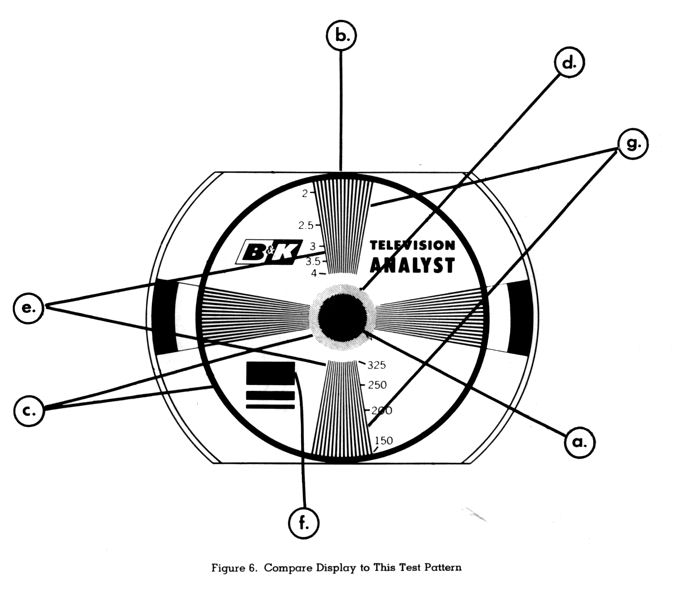BK Precision 1077B Television Analyst (1968)





The BK Precision 1077B Television Analyst is very handy for testing
and restoring vintage TVs. It was very popular in its day and you can find a used
one pretty easily. I bought mine for less than $40 in 2011.
First Look
Here's my 1077B Television Analyst on the day that I bought it, displaying
one of its standard test patterns.

Even though the 1077B is comparatively new (at least, compared to all the
old radios and TVs in this house), I brought up the power slowly, using
my metered variac. At this stage, it looks basically functional, although
the display isn't great. Height is insufficient,
vertical and horizontal linearity are both a bit off, and
the entire pattern is tilted.
Servicing the 1077B
The electrolytic capacitors in this unit are old enough to be suspect.
I bought this 1077B for practical use, not as a display piece, and it needs to
be accurate. I'll replace the electrolytics and go from there.
As befits a test instrument, the 1077B is easy to service. Removing the top
and bottom covers gives you access to most components.



Click the icons below to get the schematic and voltage chart from the 1077B manual.
These images are sized to print on 8.5 x 11 sheets. You should print them using an art program
rather than your browser. To save each file to your computer, right-click the icon and
then choose Save Picture As...



My 1077B seemed to work fine after I replaced the electrolytics and
adjusted the centering and other geometry settings, so I declared
the project complete.
1077B Test Patterns
Here are some images produced by my TV Analyst at this stage.




These patterns look decent, although a seasoned eye will detect some
slight imperfections. The TV that I'm using is one of the newer ones in this
house, but it's over 25 years old, and it has probably developed some of its
own imperfections by now. My 1077B may need a little more tweaking, as well.
Perhaps one of these days I'll haul it over to our big plasma TV to see how it
looks on a newer (and presumably more accurate) television.
The 1077B works by scanning a transparent slide held between two tubes.
The first and second screens in the previous series show two of the pattern slides supplied with
the unit. The third screen shows how it can generate color bars
electronically, with no slide inserted. (Don't take the colors in these photos
too seriously; my auto-everything camera makes most screens look too
blue under indoor lights.)
The fourth photo shows the classic "Indian Head" pattern that
many of us recall from days past. This is not a standard 1077B pattern.
I made my own slide by finding the Indian Head image online and printing
it on clear acetate.
You can make your own pattern slides just as easily, but you may find
that the homebrew slide doesn't quite match the originals in sharpness.
Perhaps using a true photographic process would give better results.
In any event, for what they're worth, here are scans of the basic 1077B
slides. Right-click each icon to save the file. Then you can print
on a transparency and trim the slide to size.





Using the Television Analyst
The next photo shows my 1077B at work. It is displaying a pattern on my
DuMont RA-113 TV, which is using a type
8XP4 test CRT on the workbench.

The standard pattern is used for seven basic tests as explained below.

-
The center of the test pattern should be at the physical center of the screen.
-
The black circle should just fill the screen vertically.
-
The black outer circle and gray inner circles should be perfectly round.
-
The shades of gray in the circles around the center should be easily
distinguishable from each other.
-
The vertical wedges extending from the center to the top and bottom of the screen
will merge and be indistinguishable near the center. Near the outside, they can
be easily distinguished from each other. Lines should be distinguishable at
3 or higher on the top scale (bandwidth 3 MHz or greater), 250 or higher on
the bottom scale (resolution 250 lines or greater).
-
There should not be a black smear at the right edge of the three black bars.
-
There should be no ringing (multiple lines similar to ghost images) on the right
edge of the vertical wedges.
Got all that?
To call the TV Analyst flexible is an understatement. Here's a
feature list:

The 1077B user manual explains these features in considerable detail. At more than
100 pages, it's far too long to reproduce here.
Another good reference is the book Television Analyzing Simplified by Milton S. Kiver.
The book is out of print, but readily available on the used market.
The TV Analyst went through several versions, beginning in the 1950s. This
forum discussion
lists the different versions. I recommend getting a 1077B, which should be
more capable and easier to service than its predecessors.
For the first few months, I used my 1077B primarily as a pattern generator.
While restoring my second Predicta TV,
I tried out another of its capabilities, injecting substitute horizontal and vertical drive signals
in place of those generated by the TV.
|